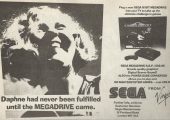For an industry so deeply rooted in entertaining children, video gaming has spent a good deal of time, money, and effort on inserting sex in its advertising. Since the early days of black and white arcade machines, the two activities have been linked in ways that were sometimes tasteful and other times downright vulgar. Reaching a peak during the late ’90s and turn of the century, the use of sexual innuendo and suggestion has slowed over the past decade, but there was a period where it was not only acceptable to focus marketing around sex, it was a common practice. Sega was no stranger to incorporating sex into its advertising around the globe, particularly in Europe and the U.S., and the Mega Drive was the recipient of some of the more jaw-dropping spots in magazines in the United Kingdom.
Putting the Joy in Joystick
 Sega’s practice of using women in provocative clothing and poses started well before the Genesis. In fact, it actually started more than a decade earlier, with ads for its arcade products in Japan and around the world. Flyers for games like Turbo and Space Odyssey included girls in tight or skimpy outfits posing with the cabinets. The Japanese Turbo ad is a particularly unimaginative one, with a young girl wearing high heels and what appears to be a formal dress that’s being blown up and to the side as though there were a strong breeze, despite the fact that her hair hangs perfectly still on her right shoulder. It’s an obvious ploy to show off her legs. Astro Fighter (later ported to the Master System) featured a girl dressed in a uniform resembling those used in the original Star Trek series. She smiled enthusiastically while she fired her laser gun off-screen. Later arcade hits would continue to use women as promotional tools. In Japan, for instance, Thunderblade was advertised using things most appealing to young males: explosions and girls. It featured the drawing of a woman from the buttocks down standing with her legs spread wide enough to show the Thunderblade helicopter and a massive explosion in the background. Perhaps players had to fight the 50 Foot Woman?
Sega’s practice of using women in provocative clothing and poses started well before the Genesis. In fact, it actually started more than a decade earlier, with ads for its arcade products in Japan and around the world. Flyers for games like Turbo and Space Odyssey included girls in tight or skimpy outfits posing with the cabinets. The Japanese Turbo ad is a particularly unimaginative one, with a young girl wearing high heels and what appears to be a formal dress that’s being blown up and to the side as though there were a strong breeze, despite the fact that her hair hangs perfectly still on her right shoulder. It’s an obvious ploy to show off her legs. Astro Fighter (later ported to the Master System) featured a girl dressed in a uniform resembling those used in the original Star Trek series. She smiled enthusiastically while she fired her laser gun off-screen. Later arcade hits would continue to use women as promotional tools. In Japan, for instance, Thunderblade was advertised using things most appealing to young males: explosions and girls. It featured the drawing of a woman from the buttocks down standing with her legs spread wide enough to show the Thunderblade helicopter and a massive explosion in the background. Perhaps players had to fight the 50 Foot Woman?
Admittedly, Sega was not the first company to employ sex as means of promoting its video games. Computer manufacturers like APF Electronics used double entendre to sell its products, and there was always an attractive girl nearby. The arcade industry produced scores of printed ads that featured scantily-clad girls playing everything from Centipede to Contra, as though it were a casual thing. The female figure was regularly employed as an advertising tool for video games, attempting to connect the two most important things to teenage boys: girls and games. To be fair, most of the ads were innocent, using the models much the way game shows of the era did, and many of the the ladies featured were modestly dressed. Moreover, no arcade ad Sega produced at the time matched the levels of the controversy generated by some of its competitors, such as Atari, whose 1973 Gotcha game caused a stir because of its breast-like controllers. The flyer shows a man grabbing a seemingly fleeing blonde by the waist. While not as suggestively dressed as other models, the woman is definitely meant to show off her body. Similarly, in 1981 Pacific Novelty, a company ironically founded by later Sega of America President Bernie Stolar, sold a game called Shark Attack, another title that centered its promotion on sex. “Thrust and munch” was the slogan (those were also the names of the game’s actual button functions), written right above a close-up of a girl’s bikini-wearing bottom which says “bite my butt.” It makes me wonder where these women were all playing their games back then. As a child of the late ’70s and early ’80s arcade scene, I must have lived in the unfortunate part of the country where women came to the arcade fully-clothed.
Sex in 16-Bits
As the ’90s arrived, game companies continued to use sex in their marketing. SNK produced its famous lingerie ad, in which a voluptuous blonde complained about her boyfriend’s lack of sexual interest, as he played his Neo Geo on a big-screen TV in the background. Sega never approached this level of sexual suggestion in the U.S. with the Genesis, given that its target audience was pre-teen and teenage boys, who were definitely interested in sex but were still minors. In contrast, the Neo Geo was a much more expensive machine and was targeted at adults, making such advertising a more sensible (and legal) choice. Overwhelmingly, the first few years of the Genesis in North America sported little to no sexual references in its marketing. Sega of America instead decided to concentrate on appearing as the “cool” video game company, and though it wanted to attract a more mature audience, sex was not a direction it wanted to explore. Former SOA head of marketing Al Nilsen explained to Sega-16 via email that Genesis games were intended to be enjoyed by all age groups, and not just the teenagers Sega hoped to steal away from Nintendo, and that sex was never a serious consideration in its advertising. “I don’t think it really was an issue that came up,” He said. “While our initial marketing was geared towards teens and young adults, we never forgot that video games were for all ages. Sonic for example, helped to make Genesis a platform for everyone.”
Other branches of the company weren’t anywhere near as discrete. The raciest Sega ads of the period came out of Europe, appearing in Viz magazine. Founded in 1979 by Chris Donald, Viz is a sort of British counterpart to Mad and Cracked magazines in the U.S., though its use of toilet humor and vulgarity exceeds what American periodicals are willing to produce. The collection of Mega Drive and Game Gear ads that Virgin Mastertronic ran in Viz were done by John Brown Publishing and were part of a marketing campaign targeted at older gamers. In addition to ads of a sexual tone, there were snippets that used toilet humor, drugs, and even violence – definitely not the kid-friendly marketing of Sega of America or even the female objectification utilized by many of its competitors. These ads were designed specifically for Viz, which was one of the most popular magazines in the UK at the time. Between 1990 and 1994, around 20 different ads were run in Viz to promote the Sega’s hardware, software, and accessories. Sega Europe even emulated the Neo Geo ad with a lingerie-wearing blonde of its own, only she was leaning back in a chair with her legs open and looking like she had just had an orgasm from playing her Mega CD.
The trend continued with the launch of the 32X in 1994, and a pair of American ads were a bit more risque than what Sega of America had previously released (by this time, Nilson had departed), leaving little to the imagination about what a 32X appeared to be doing when placed upon a Genesis console. Presenting words like “MORE! MORE!” and “FASTER! FASTER!” in large, black letters across the top of the page may have been lacking in subtlety, but it at least bore some relevance to the improved power and processing that “those two Sega machines” were doing to each other (making an arcade system, of course!). Unsurprisingly, a European 32X spot was much more visual than its American counterparts and showed a nearly-bare woman kneeling, a Mega Drive and 32X clutched provocatively between her legs.
The Competition Follows Suit
 Sega pivoted more towards including sex in its ads during the 1990s and generally embraced more aggressive and controversial marketing. In doing so, it pulled the rest of the video game industry along with it (read more about that here), and even Nintendo would stray from its squeaky-clean image by the middle of the decade. Attempts by the Mario maker to become “edgier” and “cool” resulted in a questionable promotion, such as the infamous Game Boy Pocket print ad that showed a girl wearing a tight dress tied to a bedpost, her expression of fearful anticipation quite clear. What isn’t as clear is how what appeared to be either a session of S&M or impending rape had to do with playing Game Boy. Nintendo would continue this uncharacteristic line of advertising, and one later promo for the Game Boy Advance featured a series of ads that parodied perfume commercials. One had a couple in their bed and about to engage in sex while a GBA rested on a nearby pillow. The second part then showed the man playing the device while his naked girlfriend slept next to him, both under the tagline “the second best thing to do in the dark.” The ad was especially bold because one of the woman’s breasts was almost entirely visible. Somewhere, Calvin Klein either shed a single tear or ran to consult his lawyer.
Sega pivoted more towards including sex in its ads during the 1990s and generally embraced more aggressive and controversial marketing. In doing so, it pulled the rest of the video game industry along with it (read more about that here), and even Nintendo would stray from its squeaky-clean image by the middle of the decade. Attempts by the Mario maker to become “edgier” and “cool” resulted in a questionable promotion, such as the infamous Game Boy Pocket print ad that showed a girl wearing a tight dress tied to a bedpost, her expression of fearful anticipation quite clear. What isn’t as clear is how what appeared to be either a session of S&M or impending rape had to do with playing Game Boy. Nintendo would continue this uncharacteristic line of advertising, and one later promo for the Game Boy Advance featured a series of ads that parodied perfume commercials. One had a couple in their bed and about to engage in sex while a GBA rested on a nearby pillow. The second part then showed the man playing the device while his naked girlfriend slept next to him, both under the tagline “the second best thing to do in the dark.” The ad was especially bold because one of the woman’s breasts was almost entirely visible. Somewhere, Calvin Klein either shed a single tear or ran to consult his lawyer.
Nintendo’s use of sex in its marketing would be short-lived and never as outwardly controversial as Sega’s, but it showed that video games had indeed grown up. The use of sexual innuendo in Sega’s advertising would continue beyond the 16-bit era, and the Saturn featured spots for several games that at the very least raised some eyebrows. From an ad suggesting masturbation to a centerfold-like layout mid-magazine that featured several Saturn titles strategically laid out over a naked beauty, it was clear that Sega was looking to shock as well as sell. Ultimately, the advertising did little to reverse the company’s fortunes in North America, and many gamers were left wondering why the spots didn’t focus on the games themselves instead of players’ hormones.
Changing Focus
Sega’s use of sex in its marketing was never as bold in North America as it was in Europe (just take a look at the ‘70s-themed ad for Sega Rally 2), but that didn’t mean the company didn’t try. As the decade wore on, however, the publisher decided to make its advertising more ambiguous to reflect what it believed to be changing sensibilities. The problem was that leaving the message of its ads up to reader interpretation meant giving up a lot of the shock and awe that sex often provided. Sega announced that it was allocating $100 million for advertising the Dreamcast and hired the firm of Foote, Cone and Belding (FCB) out of San Francisco in 1997 to promote its products. The Dreamcast would become the center focus of the firm’s efforts. Shortly after the announcement, Chuck McBride, FCB’s group creative director on the Sega account explained the radical departure from the in-your-face style used by Sega’s old marketing partner, Goodby, Silverstein & Partners. “There’s so much game footage on the TV set, and, frankly, people are sick of seeing it. We really wanted to do something different with Sega, and take an approach where [viewers are not] sure if they’re seeing a gaming commercial or a short story that can stand on its own.” FCB’s first move was to replace the Sega Scream with “Hard Stuff” at the end of each commercial. When the Dreamcast launched in 1999, McBride’s description of FCB’s advertising was ramped up. Take the print ad for Seaman on the Dreamcast. Though it has three screen shots on the right side of its two-pages, the piece also presents a man’s feet on top of a very large fish fin in bed, implying that the two are having sex, while the line “I will not mate outside my species” runs several times at the top of the page. Readers were puzzled about the story behind the image, and it hopefully provoked curiosity about Seaman. It would have been very interesting to have been a fly on the wall during the firm’s presentation for this ad and hear what SEOA CEO Peter Moore and VP of Strategic Planning and Corporate Affairs Charles Bellfield thought about it.
The Dreamcast was Sega’s swan song in hardware, and many factors can be attributed to its failure to compete with the Playstation 2. Marketing is considered a large part in that, whether it stems from Sega’s inability to ultimately produce the $100 million it had announced or from the direction it took with the console overall. In an interview with Famitsu magazine in 2013, former Sega of Japan marketing veteran Tadashi Takezaki discussed the game giant’s efforts to appeal to as broad an audience as possible with the console, a direct contrast to its previous focus on creating a diehard fan base. Everything, even the physical design and color choice of the Dreamcast was chosen with this purpose in mind. “We did our best to make the console approachable to a mass audience,” Takezaki explained, “from the system’s design and coloring to the name itself. As a result, we went with a compact, simple design with a warm color scheme, something completely different in look from older Sega systems. I think it was the console that we took the most complete marketing approach with.” How Takezaki was able to reconcile this approach with advertising that featured inter-species sex with fish is unknown, but it was apparent that by this time Sega as a whole was beginning to change the direction of its marketing, and a more wholesome approach soon spread across to its U.S. and European subsidiaries.
More Games, Less Libido
I don’t fault Sega for using sex in its advertising. Companies have been doing it for decades, and when your principal audience is comprised of young males, it makes perfect sense. I do question the effectiveness of such a campaign for video games, though. The Dreamcast ads were ineffective in increasing console sales, and that could have much to do with how they didn’t really have anything to do with the games they advertised. No one was going to buy Seaman because they saw what seemed to be man-on-fish sex. Perhaps it was just an attempt to be silly and show that Sega was a company that knew how to kid around. This, I think, would have been just as ineffectual, given that Sega had spent half the decade trying to demonstrate that it made products for an older, more mature audience. Toilet humor and sex jokes wouldn’t go over too well with such a demographic.
 Time passed, and Sega eventually withdrew from the hardware market in 2001. Its advertising has been decidedly tamed in the U.S. since then, and even its racier European subsidiary has managed to keep its marketing pants on. Ironically, the use of sex in advertising by other companies has become more common in the U.S. (and a lot more tawdry) since the heyday of the Genesis, and graphic depictions of the act itself can now also be found in many games, like the Witcher and Mass Effect. The amount of impact Sega’s use of sex in its advertising had on its actual game sales is unclear, and even today there are questions regarding the effectiveness of the entire practice. For example, a 2015 meta-analysis of 53 studies that included over 8,000 participants found that sexual advertising had no significant impact on memory or buying intentions. It also found that brands that used sexual ads were less remembered by consumers than those that used non-sexual (and non-violent) ads. What responsibility Sega had in moving the industry to this point is highly debatable, but what is certain is that the software giant definitely played a part in showing that video gaming was an industry that could handle adult sensibilities and tastes.
Time passed, and Sega eventually withdrew from the hardware market in 2001. Its advertising has been decidedly tamed in the U.S. since then, and even its racier European subsidiary has managed to keep its marketing pants on. Ironically, the use of sex in advertising by other companies has become more common in the U.S. (and a lot more tawdry) since the heyday of the Genesis, and graphic depictions of the act itself can now also be found in many games, like the Witcher and Mass Effect. The amount of impact Sega’s use of sex in its advertising had on its actual game sales is unclear, and even today there are questions regarding the effectiveness of the entire practice. For example, a 2015 meta-analysis of 53 studies that included over 8,000 participants found that sexual advertising had no significant impact on memory or buying intentions. It also found that brands that used sexual ads were less remembered by consumers than those that used non-sexual (and non-violent) ads. What responsibility Sega had in moving the industry to this point is highly debatable, but what is certain is that the software giant definitely played a part in showing that video gaming was an industry that could handle adult sensibilities and tastes.
Sources:
- Gifford, K. (2013, Aug. 07). Why did the Dreamcast fail? Sega’s marketing veteran looks back. Polygon.
- Kelly, J.I. (1997, Sept. 29). FCB to launch first work for Sega: New TV spots try to be ‘more approachable’ than Goodby’s ads. Adweek.
- Nilsen, A. (2016, Aug. 6). Personal communication with Ken Horowitz.
- Plante, C. (2014, Sept. 09). This is Sega’s $100 million marketing plan that failed to save the Dreamcast. The Verge.
- Takahashi, D. (2015, March 20). At 68, Bernie Stolar is still running ambitious game startups. VentureBeat.

























That’s the first time I’ve seen naked hairy balls in a videogame ad, so theres that I guess…
I adored Sega during the Genesis/MD era, but when I think back on those ads, I recall being greatly disappointed. The ads were obvious attempts to lure me in by my loins and had nothing to do with the games. It was insulting. The game screenshots, previews and reviews in magazines like GameFan and other publications had an impact on my decision making, not pathetic attempts to get my interest with innuendo.